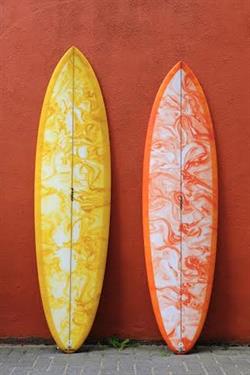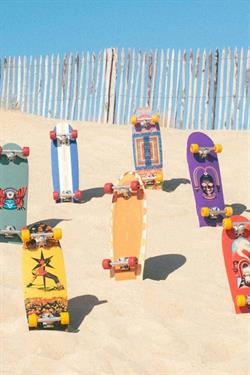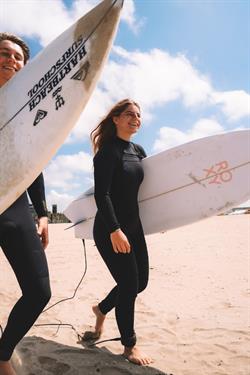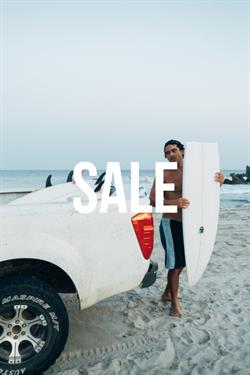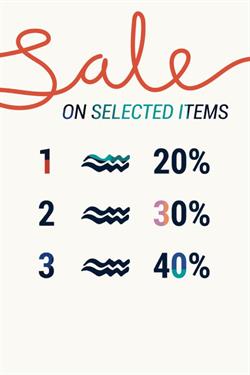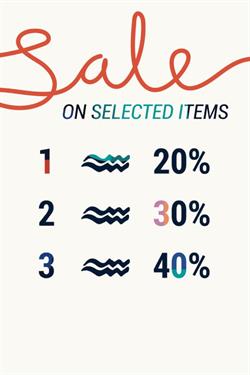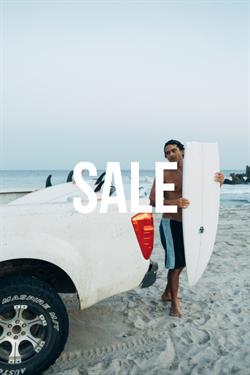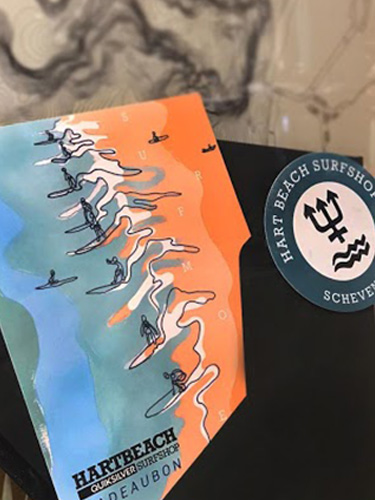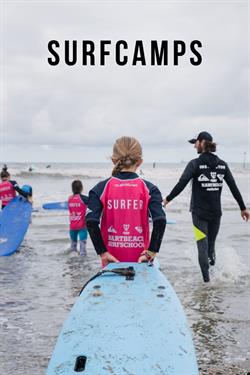Buying a surfboard is a very special moment! Whether it's your absolute first surfboard or the 20th in your collection, it doesn't matter. Holding a new board for the first time can transform the strongest and ‘manliest’ man into a 12-year-old girl standing next to Justin Bieber. Alas, buying a surfboard is usually also a large investment. Therefore, nothing will pay off more than educating yourself! To help you with this purchase, and ensure you have as much information as possible for your decision, we've put together this surfboard guide for you.
Surfboard Guide
Standard Board Information:
If we were to explain all things surfboards in a short moment, an overdose of surf ‘lingo’ would be mentioned. To avoid any confusion, we explain the basics about surfboards. A surfboard has a 'top' (the top) and a 'bottom' (the bottom). The sides are called the 'rails'. The front is called the 'nose' and the back is called the 'tail'. On most boards, you will notice a stripe through the middle of your board. This is referred to as the "stringer" and is the center of the board. Usually, this stringer is made of wood and ensures that the board is stronger. At the bottom and back of your board, you will find the 'fins'. They ensure that the board has more stability and is easier to steer. You can read more about the differences in fins later on in this surfboard guide. At the top of the tail is a 'leash plug' and this is where your 'leash' is connected to your surfboard. The leash is then attached to your ankle so that you do not lose the board while surfing. You can also read more on the leash later on in this surfboard guide.
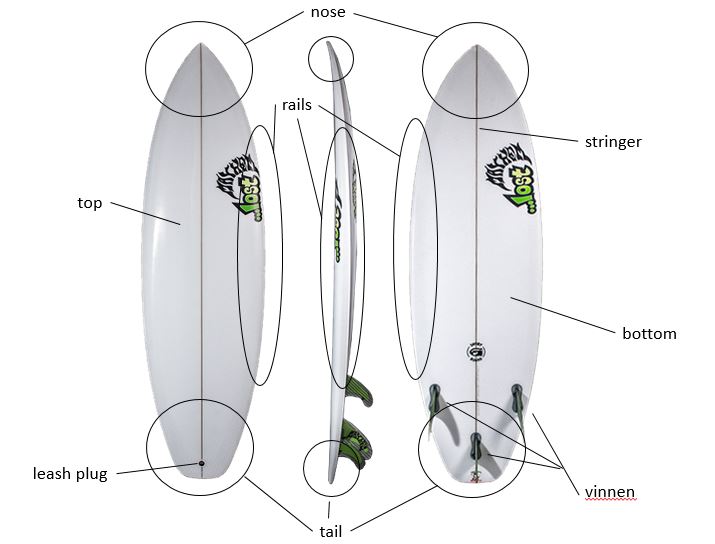
Surfboard sizes:
As a general rule, the sizes of a surfboard are indicated in 'feet' and 'inches'. Converted, 1 foot equals 30.48 cm and 1 inch equals 2.54 cm. To make our lives easier, we just simply calculate with 1ft=30cm and 1inch=2.5cm. The dimensions of a board are always indicated with three sizes. For example: 6'1 x 19' 1/2 x 2' 1/4. The first number (6'1) represents the length of the board. So the board is 6 feet and 1 inch long (approx. 182.5cm). The second number indicates the width of the board. This board is therefore 19 and 1/2 inches wide (approx. 48.75 cm). Finally, the third number indicates the thickness. So the example board is 2 and 1/4 inch thick (approx. 5.62cm). All boards worldwide are indicated this way. On some boards, it is also indicated in centimeters. Nowadays, you can often find the volume of the board noted in Liters. This is also commonly known as buoyancy on surfboards. The more liters the board has, the better the board floats and the easier it is to paddle, keep balance, catch waves and surf.
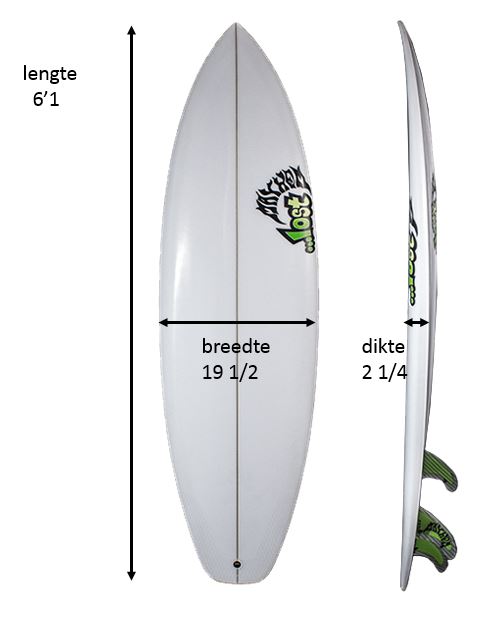
WHAT ‘SHAPES AND FORMS’ (OF SURFBOARDS) ARE OUT THERE?
Shortboard (usually under 7 feet):
Most people will have spotted a shortboard before. It is a short, narrow and slightly thinner board whose rails are often quite sharp. These types of boards are made for the advanced surfers out there. A shortboard works best in bigger and firmer waves.
Fish board/ Hybrid board (usually under 7 feet):
These boards share many similarities to a shortboard. The difference between them mainly lies in the thickness and width of the board. These boards are typically a bit thicker and wider than shortboards. For that reason, such boards distinctly have more 'volume' (buoyancy); making paddling, catching waves and building speed a lot easier. These boards are frequently used by advanced surfers who surf a lot in small and slack waves. However, they are also very well suited for surfers who already have experience surfing and are now looking to take the next step with their board.
Funboard or Mini Malibu (between 7' and 8'11 feet):
These boards are the intermediate option between longboards and shortboards. Due to the length, thickness and width, the boards have a high volume, but they are still able to turn more smoothly than a longboard. That is why these boards are best suited for the novice surfers who are looking to invest in their first board. You can also often find this board among advanced surfers, who simply have it as an intermediate board for days they "just want to play around a little".
Longboards (from 9 feet):
Here comes the classic surfboard! Longboards were the ultimate first surfboards to catch waves. These boards are at least 9 feet long. This of course gives you a lot of volume, making paddling and catching waves very easy. When you're surfing, you have to put in quite some force to move these boards into the bend. Surfers also enjoy ‘dancing’ and walking back and forth on their boards.
SUP board (usually 10+ feet):
These days, you can see more and more SUPs (Stand Up Paddleboards) around. SUPs are very, very large. This way you stay on the board the entire time and paddle with a large paddle. There are also notable differences between SUPs that are made for surfing and SUPs that are only made for paddling through ditches or long distances.
The Gun (Note: also available in smaller sizes!! 7'- 12'+ feet):
These boards are specially made for 'Big Wave Surfing'. The boards resemble a shortboard in shape, but have the length of a Funboard or Longboard. NOTE: One may often think that they are well suited for novice surfers due to its high volume, but that is not the case! While these boards are long, they are also small, thin and have sharp rails. Such things are not suitable for normal surfing and therefore, guns are really made for surfing very high waves.
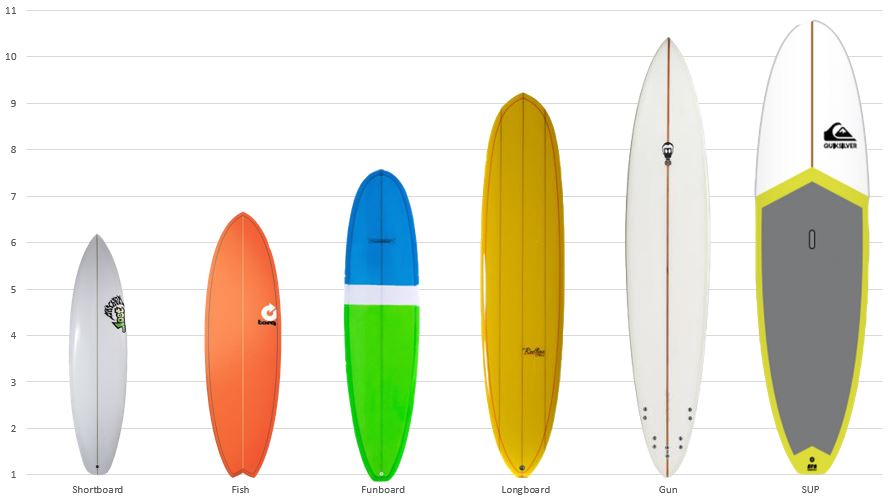
Check out our collection of surfboards here
THE DIFFERENT MATERIALS:
It is not only important to pay attention to the size of your board, but you also have to look at its material. Nowadays, you have significant differences in this. Note: There is no better or worse material, simply a preference from one surfer to another.
PU - Polyester:
The core of these boards is made from a PU polystyrene foam with a wooden stringer. Surrounding this are fiberglass mats that are finished with resin. When this material hardens, the boards become quite light. A disadvantage of this is that the material is vulnerable, so you should always handle PU boards with proper care. If there is a ‘ding’ (hole) in it, you have to have it repaired (or repair it yourself) before you surf it again. Otherwise, the board will fill up with water and become heavy. Polyester boards are the most common worldwide and are considered a very successful way to make boards.
EPS - Epoxy:
Similar to the PU polyester boards above, the foundation of these boards is made from polystyrene foam with a wooden stringer. Distinctively, this kind of EPS styrofoam is lighter than PU styrofoam. The result is a lighter board which is processed with fiberglass mats and EPOXY resin. The epoxy resin is extra strong and therefore, these boards are slightly more durable than polyester boards, and also somewhat lighter.
Plastic:
Some boards are made of plastic. You often find this with beginner surfboards. The big advantage is that these boards are super durable and almost impossible to break. However, their disadvantage is that they are typically quite heavy compared to other boards. This aspect doesn't matter much until you really start surfing at a better level and begin making your turns.
Soft-top:
Nowadays, you see soft-top surfboards more and more. They are mainly used during surf lessons. Some think that that's why these boards aren’t as good, but that's not the case at all! Softboards have been substantially developed in recent years and surf very well. The big advantage of these boards is their high buoyancy. That makes paddling and catching waves a lot easier. Many intermediate to advanced surfers will use one for days they “just want to have some fun”. The boards are also a bit softer so if you fall off your board, it's not so bad ;)
Other materials:
In recent years, a lot of research has been done into materials and boards. That is why there are now also various other surfboard materials out there to be found. Some of these boards have an extra 'protection skin' to make them more durable. On the other hand, other boards are completely contrasting and hollow inside. Again, there is no right and wrong direction here, it is only important what you as a surfer like best!
YOUR SURFBOARD - FIRST ASSESS YOURSELF:
Before you can start collecting information about which board you are going to buy, you must first determine at what level you are surfing. Here, it is very important that you are honest with yourself! If you estimate yourself wrong, it may happen that you buy an absolutely wrong board and soon don't feel like surfing anymore. If you are unsure how to determine your level yourself, it is always useful to ask for advice from a specialist. At Hart Beach Surfshop we have enthusiastic and specialized employees who are always happy to give you advice when looking for a board.
Step 1: Your level
Are you a beginner; intermediate or advanced surfer?
Beginner:
You've never surfed or only surfed a few times here and there and the 'stoke' has got you! You really want to keep surfing and get better as soon as possible. If this is you, then it's time to buy your first board and get started! As a novice surfer, it is very important in the first months/years that your board always has enough length, width and thickness. This gives your board more buoyancy (indicated in litres) and makes paddling and catching waves a lot easier. This is essential because: “If you don't catch waves, you won't learn to surf!”. Although, this does not mean that you should always go for a longboard. That used to be the case, but nowadays boards are slightly wider and thicker, giving a slightly shorter board a very high volume. So our tips for a novice surfer are Mini Malibu's or Funboards!
Intermediate:
You have been surfing for quite some time and have quite a bit of experience. Surfing green waves (unbroken part of the wave) diagonally is no longer a problem for you, and you are already working on your first small floaters and turns. Now the time has come to take the next step! You are in need of a board that has a little more volume but is clearly shorter than what you are used to. Note: Do not buy a board that is too small with very little volume!!! It is best to look at a Fish Surfboard or a Hybrid board. These boards have the advantage of being the same length as shortboards, but because they are wider and thicker - they still have a fairly high volume. For that reason, the step to a Mini Malibu/Funboard is not too big. Of course, it takes some getting used to in the first sessions with a smaller board, but as soon as you catch the first wave you will immediately notice how much easier it is to turn your board.
Advanced:
Advanced surfers have been surfing for years and have complete control of the surfboard and their position in the water. Floaters and turns are no longer a problem, and your focus is on surfing even more radically. Once you get that far, you need to take a closer look at the smaller details of your board. Surfers at this level often need more than 1 board - a “quiver” so to speak. This consists of various boards for different circumstances. An advanced surfer's quiver looks like this: a Hybrid for the somewhat smaller waves, a shortboard for the "everyday conditions" and at least 1 "step-up" for the really high and hollow waves. With a choice in “quiver”, it comes down to the preference of the surfer. How sharp should the rails be and how long do they stay sharp? What about the entry and tail rocker? Which fin setup do you put underneath, and what size and material fins do you go for? Each one is a complicated question that you cannot simply answer. That is why it would not be beneficial to explain everything in detail here. If you have any questions about these details, you can always visit the Hart Beach Surfshop or ask us in the online chat, by phone or via our email :)
Step 2: What is your height and weight?
Naturally, it is also important to look at your height and weight. If you are ten years old and weigh 45 kilos, then you should not be buying a huge funboard. Conversely, if you are very large and heavy, a slightly longer funboard may be suitable. These are small things you should pay attention to. It is always best to ask for expert advice here. This is possible with us online, in the chat or in the store face-to-face!
Step 3: What do you want to achieve?
Furthermore, you should also ask yourself what do you want to achieve? Which direction do you want to go with your surfing? Do you like classic longboarding (as in the video at “Longboards”), or would you rather become a radical shortboarder? If you like to shortboard, the best option is to look at a funboard and surf smaller and smaller boards until you eventually become a ripper.
A FEW ADDITIONAL DETAILS:
Fins:
Fins are a very complex topic. Here we only want to provide you with some standard information and not talk too much about small details. This information is going to help you get a competent basic knowledge about fins.
1: Which fin setup do you want?
‘Thruster’ setup:
The thruster has three fins under the board. This setup gives you the ideal mix between speed and maneuverability. The thruster setup is the most used setup worldwide. For the normal surfer, this is also what we recommend the most. The perfect mix for all conditions.
‘Quad Fin’ setup:
The quad-fin setup means there are four fins under the board. This setup provides more speed, but the board is also less loose. This setup is not used very much, and you most often see a quad-fin setup in very high and steep waves.
‘Twin Fin’:
This setup, of only two fins, is mainly found on retro boards. It makes your board very loose and agile.
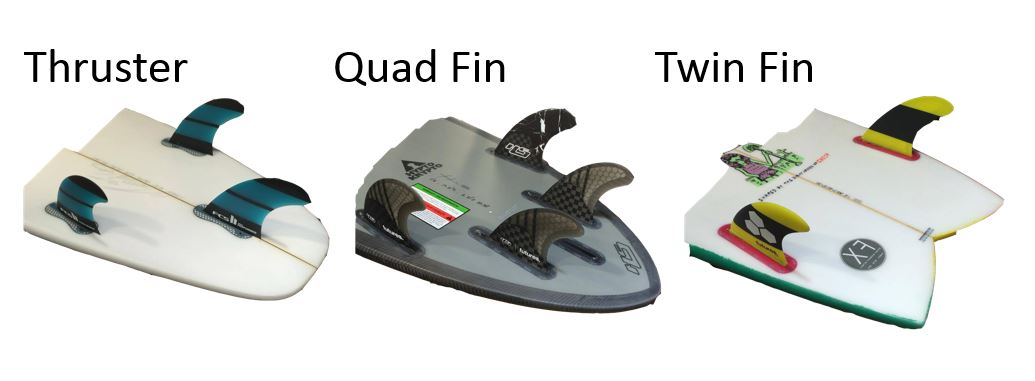
2: What size fins?
Fins come in sizes S, M and L - just like your clothes! Here you decide which size is best for your board, weight and height.
3: Which material?
Standard fins are made of plastic and are great for surfing. But of course, there are also fins made from other materials. If you take a close look at more expensive fins, they are made of a special material, such as carbon. This makes them significantly stronger and lighter than a standard fin - a big advantage, of course. View all fins at Hart Beach Surfshop
here.
Leashes:
If you are looking for a new leash, then you have to pay attention to a few things. We recommend that you always buy a leash in a surf shop so that you get a real surf leash from a brand that has experience in making them. Nothing is more annoying than a leash that is around your legs while surfing - who wants that!? It is important that your leash is of the right length. If your leash is too long, your board will fly too far away, which is inconvenient for you and dangerous for other surfers around you. If the leash is too short, it becomes very dangerous for yourself. It is best to buy a leash that is about the same length as the surfboard. Leashes also differ in thickness. Typically, longer leashes are also a bit thicker because longer boards are subsequently heavier. With shorter leashes, you also have so-called competition leashes. Competition leashes are slightly thinner so that you have less resistance in the water when you surf. Having said that, these thinner leashes are also a lot less durable.
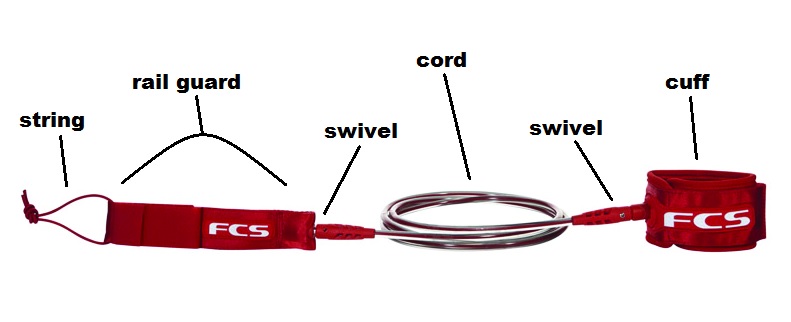
The leash is attached to the surfboard with the leash-string. It is very important that you keep the string as short as possible so that it does not come over the rails of your board. Why? Because, if you fall and there is tension on the leash, this string can grind thick holes in your rails. If your string is short enough, the railguard lies over your rail and prevents this problem. You attach the leash to your ankle with the cuff. The leash always attaches on the ankle of your back leg when standing on the board. You do have one exception: With Longboards, you sometimes have a “knee-leash”. The cuff ends up just below your knee instead. As a longboarder, you especially need this if you walk back and forth on your board a lot.
We recommend that you always ensure that your leash has a (double) swivel. A swivel is a turning mechanism that prevents the leash from spinning around your legs and hindering you from surfing a wave. A double swivel means that the leash has a swivel on the side of the rail guard and a swivel on the side of the cuff. It’s a win-win! You can find our assortment of leashes
here.
Traction pads (Tailpads):
A tailpad is a rubber mat that sits on the back of your surfboard to give you extra grip. You may ask, does a tailpad also have a function other than looking good? In short, YES!
WHY AND WHEN DO YOU NEED A TAILPAD?
A tailpad, also known as a traction pad, is a piece of rubber that is stuck to the back of a board. It replaces your wax in this spot of the surfboard. The kicktail and archbar are adapted to the shape of your foot and ensure that you always have maximum grip above your fins and tail. This equals in optimised control when controlling your surfboard.
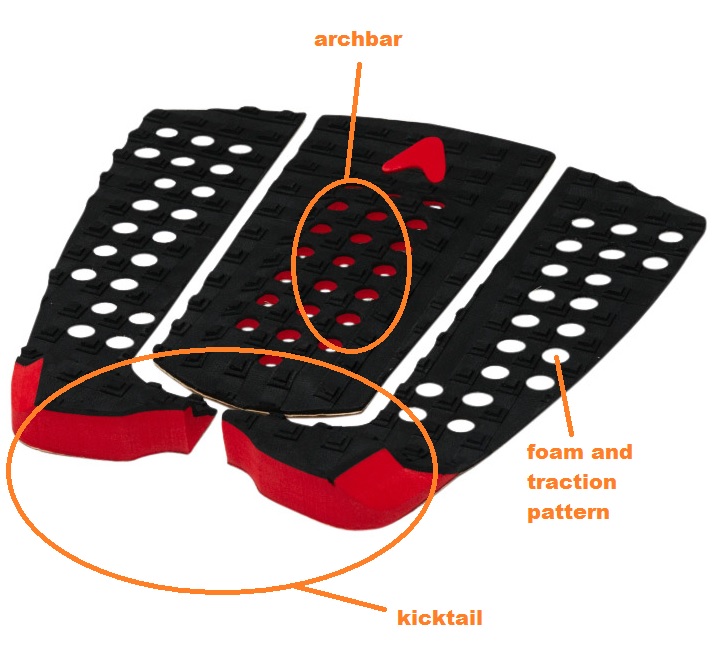
The kicktail is an elevation at the back of the tailpad. It ensures that your foot does not slip off the back of your board and that you have extra grip during a turn. The archbar is in the middle of the tailpad. It is a small rise that is adapted to the foot shape and ensures that you do not lose your grip during radical turns. Each tailpad has a different type of traction pattern - referring to the shape of the rubber. Some tailpads are slightly thicker than others or have small holes (less weight). The differences here are mainly to do with a surfer’s feeling. So, we recommend that you always stand with your bare foot on a tailpad before you buy it to see if it feels good. There are also differences in the construction of a tailpad. You have the choice between one, two, three or four pieces. This refers to how many parts the tailpad consists of. There is no better or worse here either, but it is important you choose what is best for you and how you want to stick it to the board. Surfers with larger feet also like to stick it wider so that the foot is completely on the tailpad.
Take a look at our collection of Tailpads
here.

To glue the tailpad:
It is very important that you stick the tailpad in the correct place. A tailpad should be above the rear fin so that you can steer the board perfectly. Before attaching the tailpad, you must thoroughly clean and degrease your surfboard. There should be no wax residue or greasy spots on your board. If you don't make sure the board is completely clean before you stick the tailpad on, it will come loose after a few sessions, and you will need a new one. A drying time of 24 hours is required for optimal adhesion.Surfboard Gids.
Boardbags:
If you would like to travel, a board bag is very important to protect your board against damage. For this part, you really don't have to pay attention to too many components.
- Check that the board bag is approximately the length of your board.
- Decide whether you want a single, double or triple board bag (depending on how many boards you will be traveling with of course)
- What thickness do you need? A surf sock or very thin board bag is enough for taking your board on the bike or in the car. If you really want to fly, we always recommend a thick board bag that also fully protects your surfboard.
Check our assortment of Boardbags here.
FINALLY:
This surfboard guide from Hart Beach Surfshop gives you the necessary basic knowledge about surfboards and accessories. We hope that with the help of this guide, you can find the right surfboard and/or surf accessory. If you would rather have more advice, our motivated and specialized employees are always there for you! Online, by phone and in the Hart Beach
Surfshop! :)
Surfboard brands within Hart Beach Surfshop
Torq,
NSP,
Bradley,
Hayden Shapes,
Modern,
Lost,
Salt Gypsy,
Indio,
Al Merrick,
Takayama, Lufi,
Libtech,
7S Seven,
Catch surf,
Sharpeye,
Softdog,
Slater D.,
Skindog,
CJ Nelson,
Town & Country,
Vision,
Mark Phipps,
Firewire,
Kai Sallas,
Mick Fanning Boards, Grace, Mc Tavish,
Pyzel,
Pukas,
Softech,
Walden & Wilde, Neil Purchase JR, Dead Kook, UWL Surfboards.
